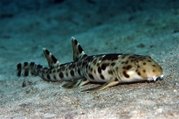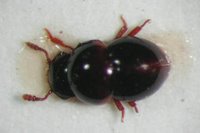DNA Barcoding
DNA barcoding was invented by Paul Hebert of the University of Guelph, in Ontario, Canada, in 2003. His idea was to generate a unique identification tag for each species based on a short stretch of DNA. Separating species would then be a simple task of sequencing this tiny bit of DNA. Dr Hebert proposed part of a gene called cytochrome c oxidase I (COI) as suitable to the task. All animals have it. It seems to vary enough, but not too much, to act as a reliable marker. And it is easily extracted, because it is one of a handful of genes found outside the cell nucleus, in structures called mitochondria.That is pretty cool that they were able to find a section of DNA that uniquely identifies a species and that can be determined so cheaply.
The idea worked, and it has dramatically reduced the time (to less than an hour) and expense (to less than $2) of using DNA to identify species.
More information on barcoding can be found a the Consortium for the Barcode of Life (and this .pdf is particularly informative).
Turns out that the barcode isn't exactly the same for a species, but it differs by much less than when compared to other species.
Barcodes affirm the unity of the species Homo sapiens. Comparison of COI barcode sequences shows we typically differ from one another by only one or two base pairs out of 648, while we differ from chimpanzees at about 60 locations and gorillas at about 70 locations. Large intraspecific differences may signal the presence of hidden species, as for example in the recent recognition of two species of orangutan.I was curious how many species would have the same (or very similar) barcodes. If it is only 2% then this methodology ought to work pretty well.
A comparison of mitochondrial sequences from 2238 species in 11 animal phyla showed 98% of closely related species pairs had more than 2% sequence difference, which is enough for successful identification of most species.
Where does this barcoding project go from here?
Dr Hebert hopes to have half a million barcodes available online within the next five years. Both his laboratory at Guelph and the Smithsonian's Laboratories of Analytical Biology can sequence the COI gene rapidly, and have thus been dubbed “barcode factories”, so this looks feasible.This dovetails nicely with the the Encyclopedia Of Life project. I hope they are working together.
In the long term, barcoding enthusiasts envisage something called a “barcoder”. It will be a hand-held device that reads barcodes on the spot.Sounds all Star Trek, but I definitely want me one of these hand-held devices.
And my favorite use of barcoding?
America's Federal Aviation Administration and its air force are working on bird barcoding. They want to scrape bits of tissue from planes, discover which birds are most often being struck, and thus work out which bird-migration routes to avoid.Nice.
via The Economist

















